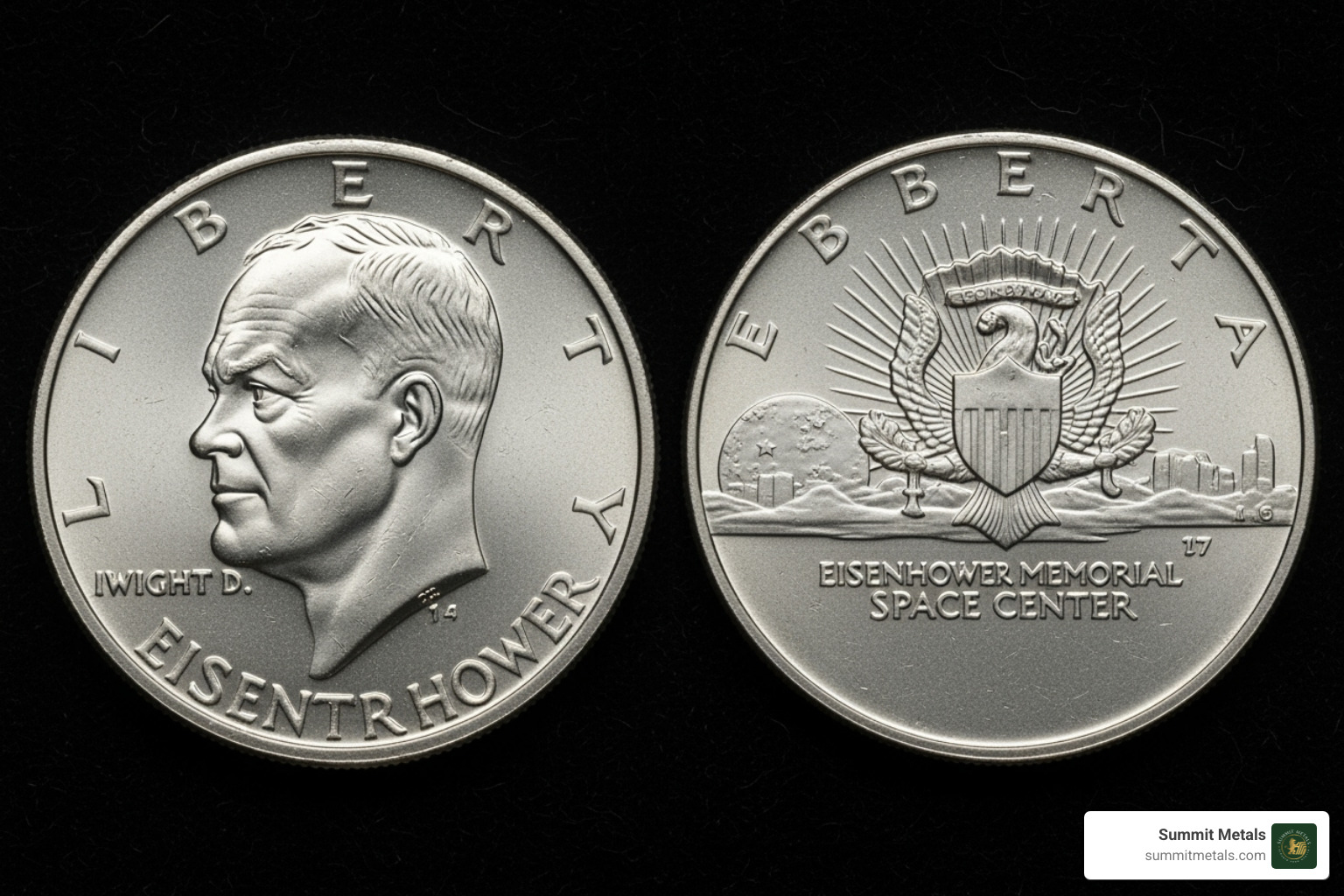Opening Up the Value of Your Eisenhower Silver Dollar
The Story Behind the "Ike" Dollar: A Tribute in Metal
Get ready to dive into the fascinating story of the eisenhower silver dollar, often affectionately called the "Ike" dollar! This coin holds a truly special spot in American history. Minted from 1971 through 1978, it was the first dollar coin the United States Mint had produced since way back in 1935.
Its creation was a blend of heartfelt tribute and clever compromise. The idea was to honor two major events from 1969: the passing of beloved President Dwight D. Eisenhower in March, and humanity's incredible triumph, the Apollo 11 moon landing, in July. What a year!
After decades without a dollar coin in circulation, Congress saw a chance to pay respects to a great leader and celebrate our giant leap into space. The talented Frank Gasparro, the U.S. Mint's Chief Engraver, was given the task to bring this vision to life.
However, there was a snag: silver prices were on the rise. To make sure people wouldn't just hoard the coins for their silver, a smart solution was found. Most "Ike" dollars would be made from a copper-nickel blend for everyday use. But special collector versions, including the sought-after eisenhower silver dollar, would contain 40% silver.
Interestingly, despite all the excitement, the Eisenhower dollar never really caught on for daily spending. Its large size and weight made it a bit clunky, and vending machines weren't set up to accept it. Many of these coins ended up being used in Nevada casinos as a convenient alternative to casino tokens. Yet, this very "unpopularity" in circulation has made it even more appealing to collectors! Its limited production run and status as the last large-size dollar coin make it a truly intriguing piece of our past. For anyone exploring U.S. coinage, understanding the value of these historical pieces is key, much like you'd learn about our Half Dollar Coin Value Guide: Turning Coins into Cash.
Design and Symbolism: From President to Moon Landing
The look of the Eisenhower dollar is packed with meaning, reflecting the two important stories it tells.
On the obverse design, you'll see a dignified portrait of President Dwight D. Eisenhower, facing left. This classic image was created by Frank Gasparro. Around his likeness, you'll find "LIBERTY" at the top and "IN GOD WE TRUST" below. The year it was minted is clearly shown at the bottom. This side really anchors the coin in American leadership and values.
The reverse design, also sculpted by Gasparro, drew its inspiration straight from the Apollo 11 mission badge. It shows a powerful bald eagle, our national bird, landing on the moon. The eagle holds an olive branch, a symbol of peace, and Earth is visible in the background. Thirteen stars, representing the original colonies, circle this amazing lunar scene. You'll also see "UNITED STATES OF AMERICA," "E PLURIBUS UNUM," and "ONE DOLLAR" completing this iconic picture. Fun fact: Gasparro's first eagle design was apparently thought to be "too fierce" by the U.S. State Department, so he had to soften its look a bit before it was approved!
The Special Bicentennial Design (1776-1976)
The Eisenhower dollar also played a special part in celebrating our nation's 200th birthday!

For 1975 and 1976, the Eisenhower dollar, along with the quarter and half-dollar, got a temporary new look. Here's a key point: there are no Eisenhower dollars dated 1975! All coins made in 1975 and 1976 proudly display the dual date '1776–1976'. This was done to give the Mint enough time to prepare these special commemorative coins, with production starting almost two years early.
The Bicentennial reverse was designed by Dennis R. Williams. It features a striking image: the Liberty Bell shown against the moon. This clever design beautifully connects our nation's founding with its incredible journey into space. While these Bicentennial coins were made in huge numbers—over 200 million were minted—making them quite common, specific silver versions and rare errors can still be very valuable for collectors. These commemorative coins remain a popular part of the series because of their deep historical meaning.
Is Your Eisenhower Dollar Made of Silver? How to Tell
Ah, the age-old question for anyone holding one of these magnificent coins: "Is my eisenhower silver dollar actually made of silver?" It's a fantastic question, and one we hear all the time! Despite the popular nickname, the truth is, most "Ike" dollars you encounter aren't silver at all. Only special collector editions, specifically minted at the San Francisco Mint, boast that precious 40% silver content.
Knowing how to spot these silver treasures is super important, because their inherent metal value can make a huge difference in their worth. Think of it like this: a regular coin is just a coin, but a silver coin holds an extra layer of value, much like understanding other forms of "junk silver" that we dive into with our guide: An Essential Guide to Valuing Constitutional Silver.
Most of the Eisenhower dollars made for everyday use are what we call "copper-nickel clad." That means they're mostly copper (about 91.67%) with a touch of nickel (8.33%). The special collector versions, however, are a different story! They’re 40% silver and 60% copper, sometimes referred to as "billon." This difference in what they’re made of is the main reason some Ike dollars are worth more than just one dollar.
The Weight Test: The Easiest Way to Identify a Silver "Ike"
Ready for the simplest, most reliable trick to see if you have a silver Ike? Grab a scale! Because of their different metal mixes, clad and silver Eisenhower dollars have noticeably different weights.
Here's what to look for:
- Your standard copper-nickel clad Eisenhower Dollars usually weigh in at about 22.68 grams.
- However, if you have a genuine 40% silver Eisenhower Dollar, it will feel a bit heavier, clocking in around 24.59 grams (or sometimes you'll see it listed as 24.624 grams).
That almost 2-gram difference might not sound like much, but trust us, it’s enough to be easily detected! A simple kitchen scale that measures in grams, or a dedicated coin scale, will do the trick perfectly. If your Ike is tipping the scales closer to that 24.6-gram mark, give yourself a pat on the back – you've likely found a 40% silver version!
Visual Clues: The Edge and Mint Mark
While the weight test is your go-to, there are a couple of visual hints that can also help you identify your eisenhower silver dollar.
First, take a peek at the edge of the coin. If you have a regular copper-nickel clad coin, you'll probably spot a distinct copper stripe running through the middle of the edge, sandwiched between the silvery outer layers. This is a dead giveaway that it's not silver. But if you’re holding a 40% silver Eisenhower dollar, its edge will look solid and uniformly silver-colored, with no tell-tale copper stripe peeking through. That's because even the core of these silver coins has some silver in it, making the whole edge appear consistent.
Next, look for the mint mark. This tiny letter tells you where your coin was made. All the special 40% silver Eisenhower dollars were exclusively minted at the San Francisco Mint and will proudly bear an "S" mint mark. You'll find this "S" just below President Eisenhower's neck on the front (obverse) side of the coin. If your coin has no mint mark, it came from Philadelphia. If it has a "D," it was made in Denver. So, if you see that "S," it's a very strong indicator that you're holding a silver Ike!
Finally, a fun fact for collectors: these 40% silver coins were originally sold in special government packaging. The uncirculated 40% silver coins often came in blue envelopes, earning them the cute nickname "Blue Ikes." The proof versions (which have a super shiny, mirror-like finish) were tucked into brown faux wood grain boxes, leading to their moniker "Brown Ikes." Finding your coin still in its original packaging can be a real bonus for collectors!
Here’s a quick glance at the differences:
| Feature | Copper-Nickel Clad Eisenhower Dollar | 40% Silver Eisenhower Dollar |
|---|---|---|
| Mint Mark | None (Philadelphia) or 'D' (Denver) | 'S' (San Francisco) |
| Weight | ~22.68 grams | ~24.59 grams |
| Edge Appearance | Visible copper stripe | Solid silver-colored |
| Original Packaging | N/A (circulated) | Blue (Uncirculated) or Brown (Proof) |
Opening Up the Value of Your Eisenhower Silver Dollar
So you’ve got an eisenhower silver dollar in hand—what now? Its worth comes from two places:
- Melt value (for 40 % silver issues).
- Numismatic value (rarity, condition, and mint errors).
At today’s silver price, a 40 % Ike contains roughly $7 – $8 in metal, but higher-grade pieces or scarce dates can be worth far more. Because these large dollars shipped in heavy bags, finding one graded MS-65 or above is genuinely unusual, which is why top-quality coins command healthy premiums.
Key Dates and Bench-Mark Values
According to the Greysheet Catalog there are 43 basic Ike listings, ranging from about $1.60 for a common circulation piece to more than $20,000 for the scarcest silver proofs in top grade. A few highlights:
- 1973-S 40 % silver – low mintage; attractive MS/PR coins often sell for $50–$200, and still higher if certified in MS/PR-69.
- 1976 Bicentennial 40 % silver – common, yet pristine specimens can reach four figures; an MS-68 example brought $7,500.
- 1972 Type 2 (Philadelphia, clad) – fewer than 40,000 survive; high-grade coins bring several thousand dollars.
To see how changing bullion prices influence these figures, our Historical Price of Silver Graph is a handy reference. For an official mintage overview, the U.S. Mint provides a concise summary.
Errors & Varieties That Make Headlines
Mint mistakes can turn an ordinary coin into a show-stopper. Famous examples include:
- 1976 “No S” proof (the only known specimen is valued around $850,000).
- 1971-S prototype strikes (three recorded; one realized $264,000).
- 1977-D struck on a silver planchet (about 15 pieces exist; one sold for $26,400).
- 1974-D Doubled-Die Obverse, plus the whimsical “Peg-Leg” and “Friendly Eagle” varieties, all of which carry healthy premiums.
Even a small die variety can add real value, so every Ike is worth a second look!
That covers the big factors behind eisenhower silver dollar pricing. Next, let’s see where you can find these historic coins.
Where to Find and Buy Your Own Piece of History
Are eisenhower silver dollars worth collecting? Absolutely. Their short eight-year run makes a complete set realistic, and they are the last regular-issue U.S. coins with real silver.
When you’re ready to purchase, stick with sources that can guarantee authenticity:
- Summit Metals (Wyoming-based, real-time transparent pricing)
- Your local coin shop
- Regional coin shows
Always insist on a written guarantee or third-party grading for high-value pieces.
Building Your Eisenhower Collection
Most enthusiasts aim for either a 32-coin date-and-mint set or a focused 10-coin silver set. Whichever path you choose, store the coins in acid-free holders in a cool, dry place, as mishandling quickly erodes value.
For broader stacking strategies, see The Basics of Gold and Silver Stacking.
The Rarest Ike of Them All
The single known 1976 “No S” proof eisenhower silver dollar—missing its San Francisco mint mark—is considered the series’ holy grail and is currently valued at about $850,000. Owning it might be a dream, but knowing what makes it special helps you recognise other valuable mint errors in the wild.
Frequently Asked Questions about the Eisenhower Dollar
Which Eisenhower dollars are 90 % silver?
Nearly all collector-issue Ikes are 40 % silver. The main exceptions are a very small run of 1971-S 90 % silver presentation strikes and the separate 1990 Eisenhower Centennial commemorative, also struck in 90 % silver.
What is the rarest Eisenhower Dollar?
That honor goes to the 1976 “No S” proof silver dollar—an accidental omission of the mint mark. Only one example is known, and it is valued at roughly $850,000.
Are regular, non-silver Eisenhower dollars worth anything?
Circulated clad Ikes generally trade at face value, but uncirculated examples in MS-65 or better, or coins with desirable errors such as the 1972 Type 2, can be worth several dollars to several thousand dollars.
Conclusion
The eisenhower silver dollar is so much more than just a piece of currency you might find tucked away in an old drawer. It's a tangible slice of American history, a metal tribute to a beloved president, and a nod to humanity's incredible journey to the moon. Each "Ike" dollar tells a story, and understanding its nuances can truly open up its hidden potential.
Throughout this guide, we've journeyed together, learning how to spot those valuable 40% silver versions by their tell-tale weight and distinctive edge. We’ve admired the iconic designs, from Eisenhower's dignified portrait to the majestic Apollo 11 eagle landing on the moon, and even digd into the special Bicentennial editions. And, for the treasure hunters among us, we've uncovered the truly rare errors and varieties that can transform a humble dollar coin into a collector's dream worth a small fortune.
Whether you're captivated by the rich historical significance of these coins, intrigued by their potential as a silver investment, or simply love the thrill of the hunt for that rare variety, the eisenhower silver dollar offers a wonderfully compelling entry point into the fascinating world of numismatics.
At Summit Metals, we're passionate about helping you steer the exciting world of precious metals and collectible coins. Our dedication to providing authenticated gold and silver, coupled with our transparent, real-time pricing, means you can invest with complete confidence and peace of mind. Finding the hidden value in a coin like the Eisenhower dollar is a journey we absolutely love to share with our clients.
Ready to explore the shining possibilities in silver and perhaps find your own piece of coining history? We invite you to Explore our Silver products and let Summit Metals be your trusted partner.






